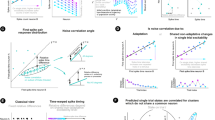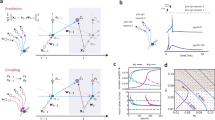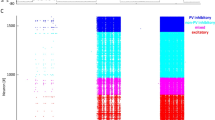Abstract
The timing of action potentials in sensory neurons contains substantial information about the eliciting stimuli. Although the computational advantages of spike timing–based neuronal codes have long been recognized, it is unclear whether, and if so how, neurons can learn to read out such representations. We propose a new, biologically plausible supervised synaptic learning rule that enables neurons to efficiently learn a broad range of decision rules, even when information is embedded in the spatiotemporal structure of spike patterns rather than in mean firing rates. The number of categorizations of random spatiotemporal patterns that a neuron can implement is several times larger than the number of its synapses. The underlying nonlinear temporal computation allows neurons to access information beyond single-neuron statistics and to discriminate between inputs on the basis of multineuronal spike statistics. Our work demonstrates the high capacity of neural systems to learn to decode information embedded in distributed patterns of spike synchrony.
Note: The PDF version of this article was corrected on the 14th of February, and the HTML version on the 16th of February. Please see the PDF for details.
This is a preview of subscription content, access via your institution
Access options
Subscription info for Japanese customers
We have a dedicated website for our Japanese customers. Please go to natureasia.com to subscribe to this journal.
Buy this article
- Purchase on SpringerLink
- Instant access to full article PDF
Prices may be subject to local taxes which are calculated during checkout








Similar content being viewed by others
Change history
14 February 2006
The PDF version of this article was corrected on the 14th of February, and the HTML version on the 16th of February. Please see the PDF for details.
References
Meister, M., Lagnado, L. & Baylor, D.A. Concerted signaling by retinal ganglion cells. Science 270, 1207–1210 (1995).
deCharms, R.C. & Merzenich, M.M. Primary cortical representation of sounds by the coordination of action-potential timing. Nature 381, 610–613 (1996).
Neuenschwander, S. & Singer, W. Long-range synchronization of oscillatory light responses in the cat retina and lateral geniculate nucleus. Nature 379, 728–732 (1996).
Wehr, M. & Laurent, G. Odour encoding by temporal sequences of firing in oscillating neural assemblies. Nature 384, 162–166 (1996).
Johansson, R.S. & Birznieks, I. First spikes in ensembles of human tactile afferents code complex spatial fingertip events. Nat. Neurosci. 7, 170–177 (2004).
Hopfield, J.J. Pattern recognition computation using action potential timing for stimulus representation. Nature 376, 33–36 (1995).
Thorpe, S., Delorme, A. & Van Rullen, R. Spike-based strategies for rapid processing. Neural Netw. 14, 715–725 (2001).
Castelo-Branco, M., Goebel, R., Neuenschwander, S. & Singer, W. Neural synchrony correlates with surface segregation rules. Nature 405, 685–689 (2000).
Nirenberg, S., Carcieri, S., Jacobs, A. & Latham, P. Retinal ganglion cells act largely as independent encoders. Nature 411, 698–701 (2001).
Perkel, D.H. & Bullock, T.H. Neural coding. Neurosci. Res. Program Bull. 6, 221–348 (1968).
Singer, W. Time as coding space? Curr. Opin. Neurobiol. 9, 189–194 (1999).
Meister, M. & Berry, M. II. The neural code of the retina. Neuron 22, 435–450 (1999).
Shadlen, M. & Movshon, J. Synchrony unbound: a critical evaluation of the temporal binding hypothesis. Neuron 24, 67–77 (1999).
Minsky, M.L. & Papert, S.A. Perceptrons (MIT Press, Cambridge, Massachusetts, 1969).
Hertz, J., Krogh, A. & Palmer, R.G. Introduction to the Theory of Neural Computation (Westview Press, Boulder, Colorado, 1991).
Gardner, E. The space of interactions in neural network models. J. Phys. A 21, 257–270 (1988).
Brunel, N., Hakim, V., Isope, P., Nadal, J.P. & Barbour, B. Optimal information storage and the distribution of synaptic weights: perceptron versus purkinje cell. Neuron 43, 745–757 (2004).
Vaadia, E. et al. Dynamics of neuronal interactions in monkey cortex in relation to behavioural events. Nature 373, 515–518 (1995).
MacLeod, K., Backer, A. & Laurent, G. Who reads temporal information contained across synchronized and oscillatory spike trains? Nature 395, 693–698 (1998).
Brody, C. & Hopfield, J.J. Simple networks for spike-timing-based computation, with application to olfactory processing. Neuron 37, 843–852 (2003).
Schnitzer, M.J. & Meister, M. Multineuronal firing patterns in the signal from eye to brain. Neuron 37, 499–511 (2003).
Kuhn, A., Aertsen, A. & Rotter, S. Higher-order statistics of input ensembles and the response of simple model neurons. Neural Comput. 15, 67–101 (2003).
Bressloff, P.B. & Taylor, J.G. Perceptron-like learning in time-summating neural networks. J. Phys. A 25, 4373–4388 (1992).
Seung, H.S. Learning in spiking neural networks by reinforcement of stochastic synaptic transmission. Neuron 40, 1063–1073 (2003).
Artola, A., Brocher, S. & Singer, W. Different voltage-dependent thresholds for inducing long-term depression and long-term potentiation in slices of rat visual cortex. Nature 347, 69–72 (1990).
Ngezahayo, A., Schachner, M. & Artola, A. Synaptic activity modulates the induction of bidirectional synaptic changes in adult mouse hippocampus. J. Neurosci. 20, 2451–2458 (2000).
Sjostrom, P., Turrigiano, G. & Nelson, S. Rate, timing, and cooperativity jointly determine cortical synaptic plasticity. Neuron 32, 1149–1164 (2001).
Lisman, J. & Spruston, N. Postsynaptic depolarization requirements for LTP and LTD: a critique of spike timing-dependent plasticity. Nat. Neurosci. 8, 839–841 (2005).
Cummings, J.A., Mulkey, R.M., Nicoll, R.A. & Malenka, R.C. Ca2+ signaling requirements for long-term depression in the hippocampus. Neuron 16, 825–833 (1996).
Malenka, R.C. & Nicoll, R.A. Long-term potentiation–a decade of progress? Science 285, 1870–1874 (1999).
Kempter, R., Gerstner, W. & van Hemmen, J.L. Hebbian learning and spiking neurons. Phys. Rev. E 59, 4498–4515 (1999).
Song, S., Miller, K.D. & Abbott, L.F. Competitive Hebbian learning through spike-timing-dependent synaptic plasticity. Nat. Neurosci. 3, 919–926 (2000).
Gütig, R., Aharonov, R., Rotter, S. & Sompolinsky, H. Learning input correlations through non-linear temporally asymmetric Hebbian plasticity. J. Neurosci. 23, 3697–3714 (2003).
Guyonneau, R., VanRullen, R. & Thorpe, S.J. Neurons tune to the earliest spikes through STDP. Neural Comput. 17, 859–879 (2005).
Legenstein, R., Naeger, C. & Maass, W. What can a neuron learn with spike-timing-dependent plasticity? Neural Comput. 17, 2337–2382 (2005).
Worgotter, F. & Porr, B. Temporal sequence learning, prediction, and control: a review of different models and their relation to biological mechanisms. Neural Comput. 17, 245–319 (2005).
Foehring, R.C. & Lorenzon, N.M. Neuromodulation, development and synaptic plasticity. Can. J. Exp. Psychol. 53, 45–61 (1999).
Seamans, J. & Yang, C. The principal features and mechanisms of dopamine modulation in the prefrontal cortex. Prog. Neurobiol. 74, 1–58 (2004).
Wespatat, V., Tennigkeit, F. & Singer, W. Phase sensitivity of synaptic modifications in oscillating cells of rat visual cortex. J. Neurosci. 24, 9067–9075 (2004).
Lisman, J. A mechanism for the Hebb and the anti-Hebb processes underlying learning and memory. Proc. Natl. Acad. Sci. USA 86, 9574–9578 (1989).
Mansuy, I. Calcineurin in memory and bidirectional plasticity. Biochem. Biophys. Res. Commun. 311, 1195–1208 (2003).
Liu, L. et al. Role of NMDA receptor subtypes in governing the direction of hippocampal synaptic plasticity. Science 304, 1021–1024 (2004).
Wang, H.X., Gerkin, R.C., Nauen, D.W. & Bi, G.Q. Coactivation and timing-dependent integration of synaptic potentiation and depression. Nat. Neurosci. 8, 187–193 (2005).
Malinow, R. & Malenka, R. AMPA receptor trafficking and synaptic plasticity. Annu. Rev. Neurosci. 25, 103–126 (2002).
Zhu, J., Qin, Y., Zhao, M., Van Aelst, L. & Malinow, R. Ras and rap control AMPA receptor trafficking during synaptic plasticity. Cell 110, 443–455 (2002).
Tomita, S., Stein, V., Stocker, T., Nicoll, R. & Bredt, D. Bidirectional synaptic plasticity regulated by phosphorylation of stargazin-like tarps. Neuron 45, 269–277 (2005).
Lisman, J., Schulman, H. & Cline, H. The molecular basis of CaMKII function in synaptic and behavioural memory. Nat. Rev. Neurosci. 3, 175–190 (2002).
Centonze, D., Gubellini, P., Pisani, A., Bernardi, G. & Calabresi, P. Dopamine, acetylcholine and nitric oxide systems interact to induce corticostriatal synaptic plasticity. Rev. Neurosci. 14, 207–216 (2003).
Mauk, M. & Buonomano, D. The neural basis of temporal processing. Annu. Rev. Neurosci. 27, 307–340 (2004).
Buonomano, D. Decoding temporal information: a model based on short-term synaptic plasticity. J. Neurosci. 20, 1129–1141 (2000).
Acknowledgements
We thank L. de Hoz, A. Globerson, M. Gutnick, D. Hansel, O. White and Y. Yarom for comments. We acknowledge computational resources provided by the Harvard University Bauer Center for Genomic Research. This work was supported in part by the German Research Foundation, the Minerva Foundation, the European Commission's Improving Human Potential Program, the Israel Science Foundation (Center of Excellence no. 8006/00) and the Defense Research & Development Directorate (MAFAT).
Author information
Authors and Affiliations
Corresponding authors
Ethics declarations
Competing interests
The authors declare no competing financial interests.
Supplementary information
Supplementary Fig. 1
Discrete tempotron architecture. (PDF 36 kb)
Rights and permissions
About this article
Cite this article
Gütig, R., Sompolinsky, H. The tempotron: a neuron that learns spike timing–based decisions. Nat Neurosci 9, 420–428 (2006). https://doi.org/10.1038/nn1643
Received:
Accepted:
Published:
Issue Date:
DOI: https://doi.org/10.1038/nn1643
This article is cited by
-
Neuromorphic Cognitive Learning Systems: The Future of Artificial Intelligence?
Cognitive Computation (2024)
-
Spiking SiamFC++: deep spiking neural network for object tracking
Nonlinear Dynamics (2024)
-
Conversion of a single-layer ANN to photonic SNN for pattern recognition
Science China Information Sciences (2024)
-
A low cost neuromorphic learning engine based on a high performance supervised SNN learning algorithm
Scientific Reports (2023)
-
Moiré synaptic transistor with room-temperature neuromorphic functionality
Nature (2023)



